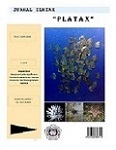Morphometric Structure of Seagrass Halophila ovalis in Tongkeina, Bunaken Subdistrict, Manado City and Mokupa, Tombariri Subdistrict, Minahasa District Coastal Waters
DOI:
https://doi.org/10.35800/jip.4.2.2016.14018Abstract
Seagrass is vascular plant with rhizome roots system, trunk system and leafs that can be differenciated. Genesal characteristic of this family, amoy others, the leaf tend to have two branches, (and absent of) ligula as been found an Potamogetonaceae family, linier form af leaf, round, oval, sessile, enlarge branch with paraleel vfinger like ciramferule connected wirb crossed lower duct or perpendicular.
This study was conducted in two locations namely Tongkeina, Bunaken Subdistrict, Manado City and Mokupa, Tombariri Subdistrict, Minahasa District coastal waters. Until recently there is no study yet been done regarding the comparison on morphological size of H. ovalis based on different sample location (near mangroves, seagrass beds and coral reefs) and comparing the result of morphological measurement among the locations studied.
Data collection was done by using exploratory survey method where samples are directly collected, washed with seawater and put it on plastic bag. The sampling site was determined by using GPS before collecting the sample of H. ovalis that consist of 20 individuals from each station. The samples that been washed and labeled were then put in the plastic bag with alcohol to avoid the damage on seagrass sample.
The results show that H. ovalis from Mokupa village is smaller than from Tongkaina. This is possibly caused the pressure of villager in Mokupa usually having their main activity to catch fish along the coastal areas which is treatening also the life of seagrass. The discarded of both organic and non organic garbages remained from house holds and local tradiitional market also can hinder the growth of H. ovalis.
Keyword : Morphometric, Halophila ovalis, Tongkaina, Mokupa
Â
Abstrak
Lamun adalah tumbuhan vascular sejati, memiliki akar dengan sistem perakaran rhizoma, struktur batang dan daun yang dibedakan dengan jelas. Halophila ovalis termasuk dalam family Hydrocharitaceae. Ciri-ciri umum dari famili ini antara lain daun cenderung bercabang dua, daunnya tidak memiliki ligula seperti yang dimiliki oleh famili Potamogetonaceae, bentuk daun linier (lurus), membulat, oval, sessile atau bercabang membesar dengan jari-jari paralel yang dihubungkan dengan saluran silang menurun atau perpendikuler.
Penelitian ini dilaksanakan di dua lokasi yaitu di Perairan Pantai Tongkaina Kecamatan Bunaken Kota Manado dan Pantai Desa Mokupa Kecamatan Tombariri Kabupaten Minahasa. Penelitian ini dilakukan karena belum ada data mengenai perbandingan morfometrik lamun Halophila ovalis di dua lokasi ini. Tujuan penelitian yaitu membandingkan ukuran morfologi Halophila ovalis berdasarkan stasiun pengambilan sampel (daerah dekat mangrove, Lamun, dan Terumbu Karang) dan membandingkan ukuran morfologi Halophila ovalis berdasarkan lokasi pengambilan sampel.
Pengambilan data dilakukan dengan menggunakan metode survei jelajah, sampel langsung dikumpulkan, dicuci dengan air laut dan dimasukkan ke dalam kantung plastik sampel. Saat pengambilan sampel dilakukan, posisi diplot dengan menggunakan GPS dan dilanjutkan dengan pengambilan sampel lamun Halophila ovalis sebanyak 20 individu setiap stasiun, kemudian sampel lamun di cuci dan di masukan dalam plastik yang sudah di berikan lebel, dan diisi alkohol agar sampel lamun tidak rusak.
Pada hasil yang di peroleh terlihat bahwa Spesies Halophila ovalis di desa Mokupa lebih kecil dibandingkan Halophila ovalis di Tongkaina. Hal ini disebabkan aktivitas masyarakat desa Mokupa dilakukan dipinggir pantai dan juga aktivitas pembuangan sampah organik.
Kata Kunci : Morfrometrik, Halophila ovalis, Tongkaina, Mokupa
1Mahasiswa Manajemen Sumberdaya Perairan FPIK UNSRAT
2Staf pengajar Fakultas Perikanan dan Ilmu Kelautan Universitas Sam Ratulangi
Downloads
Published
How to Cite
Issue
Section
License
COPYRIGHT
Authors who publish with this journal agree to the following terms:
Authors hold their copyright and grant this journal the privilege of first publication, with the work simultaneously licensed under a Creative Commons Attribution License that permits others to impart the work with an acknowledgment of the work's origin and initial publication by this journal.
Authors can enter into separate or additional contractual arrangements for the non-exclusive distribution of the journal's published version of the work (for example, post it to an institutional repository or publish it in a book), with an acknowledgment of its underlying publication in this journal.
Authors are permitted and encouraged to post their work online (for example, in institutional repositories or on their website) as it can lead to productive exchanges, as well as earlier and greater citation of the published work (See The Effect of Open Access).




















